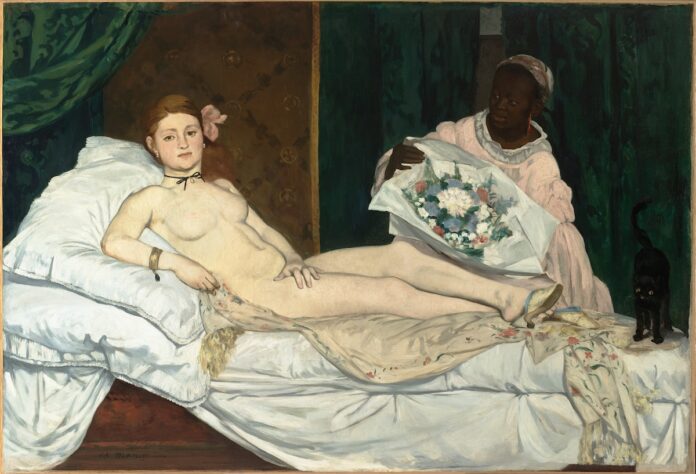“Olympia” — the Mona Lisa of modern art — has come to America for the first time. Édouard Manet began painting his masterpiece in 1863, just after Abraham Lincoln issued the Emancipation Proclamation. So its arrival stateside, as part of the forthcoming “Manet/Degas” exhibit at the Metropolitan Museum of Art in New York (Sept. 24-Jan. 7), should by rights be accompanied by bunting, brass bands and tolling bells.
[Sharp. Witty. Thoughtful. Sign up for the Style Memo newsletter.]
Lining Fifth Avenue with banners showing a mostly naked prostitute may have been more than Upper East Side sensibilities could tolerate. But remember: “Olympia,” whatever else she is, is a fiction. You can buy into the fiction if you like (“Here we have, ahem, a courtesan receiving a floral tribute from a — cough, cough — male admirer,” blah, blah). But that would make you a literal-minded bumpkin. Manet didn’t want to think of you that way. He was an affable soul who epitomized Parisian urbanity and would have loved, I think, the humor of 21st-century New Yorkers. He wanted you in on the joke.
Part of the joke had to do with style. In Manet’s heyday, the nudes that were showered with all the honors at the Salon (Paris’s annual showcase for contemporary art) were not images of real women. They were composites — sexed-up ciphers for sentimental homilies. The artists who painted them — people like William Bouguereau and Alexandre Cabanel — were rewarded for being showoffs. They created their illusions with gradations of tone so subtle as to be invisible and special effects so laboriously achieved as to all but command sighs of admiration.
Manet thought all this insufferable. He was modern. He admired real women. And he loved paint. Relishing the substrate of reality in the art of his Spanish heroes, Diego Velázquez and Francisco Goya, he kept intermediate tones to an absolute minimum, reduced facial features to a few brisk notations and outlined frontally lit bodies with stark-looking shadows. From across a room, Manet’s vivid, high-contrast paintings look suave, self-possessed and a little tart, like a plum just short of ripeness. Up close, they flicker with the energy of his ravishing brushstrokes.
To his young admirers, Manet’s style was dashing and cool. But most people saw everything that was missing: the patient buildup from dark to light, the anodyne displays of technical skill, the kitschy sentiments. It incensed them. “Olympia,” they said, was tacky and cheap, like a slapdash theater set. Proper painting surely ought to be more arduous than this. And more believable.
But Manet had no wish to supply souped-up fictions in which everyone would obediently believe. You could look at “Olympia” and concoct a cute little story about a glamorous courtesan if you wanted. But Manet made sure you would also see Victorine Meurent, his regular model, and Laure, a Black woman (family name unknown) who lived a short walk from his home in Paris’s Batignolles district. Two identifiable women, in other words, knowingly playing parts. By drawing attention to the fiction’s flimsiness, Manet exposed the mechanisms of belief and, in doing so, made his models more solidly real.
Manet deepened the game by making his sources almost comically transparent. In art history, “Olympia’s” source was the “Venus of Urbino,” Titian’s painting of a Renaissance courtesan posing as the goddess of love. In literature, its source was “The Jewels,” a poem by Manet’s close friend Charles Baudelaire. A few years earlier, “The Jewels” had been one of six poems snipped by government censors from Baudelaire’s “The Flowers of Evil” for being, in essence, too sexy.
If “Olympia,” too, is a bit filthy, it’s because its spirit is punk. Manet was a passionate republican living under an authoritarian regime; his painting’s saucy audacity was a deliberate affront to conservative taste, as dictated by Napoleon III’s paranoid, pettifogging government.
But of course, what holds us — more than the glaring nudity, the high-heeled slipper, the black neck ribbon, the jewelry or the hibiscus in her hair — is Meurent’s famous gaze. Those serenely appraising eyes refuse to be traduced by any fiction. They convey an impregnable calm that matches the unimpressed, unsurprised set of her mouth (neither the ghost of a smile nor the flicker of a frown). It is a gaze that turns the whole game back on us.



